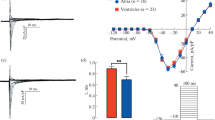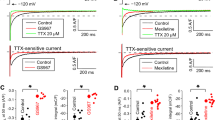Summary
The effect of dimetindene (DMI) on action potential and fast inward Na current (I Na) of frog atrial fibres was studied using double sucrose gap voltage-clamp technique. DMI reduced the amplitude and maximum rate of rise of the action potentials without altering the resting membrane potential. The drug inhibited the fast Na conductance in a concentration-dependent manner, without changing the reversal potential. The shape of the current-voltage curve along the voltage axis remained unchanged in the presence of DMI. The time to peak of the INa was not significantly altered by the drug whereas the rate of the INa inactivation (τh) was slowed. DMI shifted the steady-state inactivation curve of I Na (h∞) to more negative potentials, and increased the reactivation time constant of the sodium system (τr). The inhibition of INa was use-dependent. The results suggest that DMI interacts with the inactivation mechanism of the sodium channel of the frog myocardium, and explain its favourable antiarrhythmic activity.
Similar content being viewed by others
References
Barrett WE, Huebner CF, Rutledge RA, Deitrich A, Plummer AJ (1961) A pharmacologic investigation of dimethpyrindene maleate (Forhistal). Toxicol Appl Pharmacol 3:534–544
Bean BP, Cohen CJ, Tsien RW (1983) Lidocaine block of cardiac sodium channels. J Gen Physiol 81:613–642
Beeler GW, Reuter H (1970) Voltage clamp experiments on ventricular myocardial fibres. J Physiol (Lond) 207:165–190
Brown HF, Noble D, Noble SJ (1976) The influence of nonuniformity on the analysis of potassium currents in heart muscle. J Physiol (Lond) 258:615–629
Chen CM, Gettes LS, Katzung BG (1975) Effect of lidocaine and quinidine on steady-state characteristics and recovery kinetics of (dV/dt)max in guinea-pig ventricular myocardium. Circ Res 37:20–29
Cohen CJ, Bean BP, Tsien RW (1984) Maximal upstroke velocity as an index of available sodium conductance. Circ Res 54:636–651
Cohen IS, Strichartz GR (1977) On the voltage-dependent action of tetrodotoxin. Biophys J 17:275–279
Courtney KR (1975) Mechanism of frequency-dependent inhibition of sodium currents in frog myelinated nerve by the lidocaine derivative GEA 968. J Pharmacol Exp Ther 195:225–236
Einwachter HM, Kern R, Herb J (1979) Effect of lidoflazine on membrane currents and contraction in voltage-clamped frog atrial fibres. Eur J Pharmacol 55:225–232
Haas HG, Brommundt G (1980) Influence of intercellular clefts on potential and current distribution in a multifiber preparation. Biophys J 30:327–350
Haas HG, Kern R, Einwachter HM, Tarr M (1971) Kinetics of Na inactivation in frog atria. Pflügers Arch 323:141–157
Haas HG, Meyer R, Einwächter HM, Stockem W (1983) Intercellular coupling in frog heart muscle. Electrophysiological and morphological aspects. Pflügers Arch 399:321–335
Hauswirth O, Singh BN (1979) Ionic mechanisms in heart muscle in relation to the genesis and the pharmacological control of cardiac arrhythmias. Pharmacol Rev 30:5–63
Heistracher P (1971) Mechanism of action of antifibrillatory drugs. Naunyn-Schmiedeberg's Arch Pharmacol 269:199–212
Hille B (1977) Local anesthetics: hydrophilic and hydrophobic pathways for the drug-receptor reaction. J Gen Physiol 69:497–515
Hlavacsek-Póka E, Szentmiklosi J, Cseppento A, Szegi J (1982) A dimethindene (Fenistil) antiaritmiás hatásáról. Orv Hetil 123:2405–2407
Hodgkin AL, Huxley AF (1952) A quantitative description of membrane current and its application to conduction and excitation in nerve. J Physiol (Lond) 117:500–544
Hondeghem LM, Katzung BG (1977) Time- and voltage-dependent interactions of antiarrhythmic drugs with cardiac sodium channels. Biochim Biophys Acta 472:373–398
Hondeghem LM, Katzung BG (1984) Antiarrhythmic agents: The modulated receptor mechanism of action of sodium and calcium channel-blocking drugs. Ann Rev Pharmacol Toxicol 24:387–423
Jakobsson E, Barr L, Connor JA (1975) An equivalent circuit for small atrial trabeculae of frog. Biophys J 15:1069–1085
Kohlhardt M, Bauer B, Krause H, Fleckenstein A (1972) Differentiation of the transmembrane Na and Ca channels in mammalian cardiac fibre by the use of specific inhibitors. Pflügers Arch 335:309–322
Lorenz W, Thermann M, Hamelmann H, Schmal A, Maroske D, Reimann HJ, Kusche J, Schingale F, Dormann P, Keck P (1973) Influence of H1- and H2-receptor antagonists on the effects of histamine in the circulatory system and on plasma histamine levels. In: Wood CJ, Simkins MA (eds) Int Symposium on Histamine H2-receptor antagonists. Deltakos (UK) Ltd, London, pp 151–162
McGuigan JAS (1974) Some limitations of the double sucrose gap, and its use in a study of the slow outward current in mammalian ventricular muscle. J Physiol (Lond) 240:775–806
Mészáros J, Hlavacsek-Póka E, Szegi J (1983) Effect of dimethindene, an antihistaminic drug, on the transmembrane potentials of mammalian myocardium. Experientia 39:400–402
Mészáros J, Szegi J (1983) Action of dimethindene on the electrophysiological and mechanical properties of atrial and ventricular myocardium of guinea pig. Eur J Pharmacol 96:45–52
Rougier O, Vassort G, Stämpfli R (1968) Voltage clamp experiments on frog atrial heart fibre with the sucrose gap technique. Pflügers Arch 301:91–108
Starmer CF, Grant AO, Strauss HC (1984) Mechanisms of use-dependent block of sodium channels in excitable membranes by local anesthetics. Biophys J 46:15–27
Tarr M, Trank JW (1974) An assessement of the double sucrose-gap voltage clamp technique to frog atrial muscle. Biophys J 14:627–643
Thermann M, Lorenz W, Schmal A, Schingale F, Dormann P, Hamelmann H (1977) Influence of H1- and HZ-receptor antagonists on the circulatory system and on the endogenous plasma histamine concentrations in dogs. Agents Actions 7:97–101
Trautwein W (1973) Membrane currents in cardiac muscle fibers. Physiol Rev 53:793–835
Vaughan Williams EM (1975) Classification of antiarrhythmic drugs. Pharmacol Ther Bl:115–138
Weidmann S (1955) Effects of calcium ions and local anaesthetics on electrical properties of Purkinje fibres. J Physiol (Lond) 129:568–582
Author information
Authors and Affiliations
Rights and permissions
About this article
Cite this article
Mészáros, J., Markó, R., Kelemen, K. et al. Blockage of the fast sodium current by dimetindene in frog auricular fibres. Naunyn-Schmiedeberg's Arch Pharmacol 335, 321–325 (1987). https://doi.org/10.1007/BF00172804
Received:
Accepted:
Issue Date:
DOI: https://doi.org/10.1007/BF00172804




